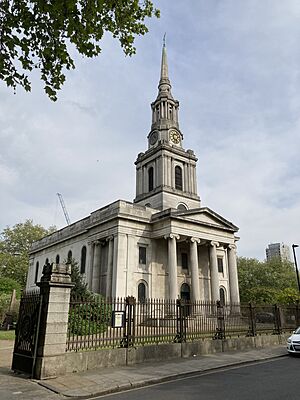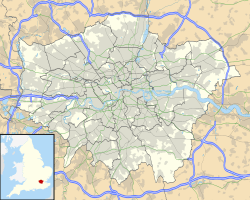All Saints Church, Poplar facts for kids
Quick facts for kids All Saints, Poplar |
|
|---|---|
 |
|
| 51°30′35″N 0°0′44″W / 51.50972°N 0.01222°W | |
| Denomination | Church of England |
| Churchmanship | High Church Anglo-Catholic |
| History | |
| Dedication | All Saints |
| Administration | |
| Parish | Poplar |
| Deanery | Tower Hamlets Deanery |
| Diocese | Diocese of London |
| Province | Province of Canterbury |
All Saints Church, Poplar, is a beautiful church located in Newby Place, Poplar, a part of East London. It is the main Church of England parish church for the area. This historic church was built a long time ago, between 1821 and 1823. It was made to serve the people of Poplar, who had just become their own parish. On July 19, 1950, All Saints Church was officially recognized as a Grade II listed building, meaning it's an important historical building that needs to be protected.
History of All Saints Church
Early Beginnings in Poplar
The story of Poplar goes back a long way, even before the church was built. In 1396, the small village of Poplar, along with Blackwall, was given to a group of monks called Cistercians. They were from an abbey near the Tower of London. This area became known as one of the "Tower Hamlets."
The people living here helped the growing City of London. They worked as soldiers at the Tower and grew crops and raised animals on the land. By the time the land was sold to private families during the time of Henry VIII, the Blackwall area was already famous for building and fixing ships.
17th Century Life and Trade
Back then, St Dunstan's, Stepney was the main church for Poplar. Records from the early 1600s show that more than half the fathers in Poplar worked on rivers or at sea. In 1614, the East India Company, which traded spices, set up its main shipyard in Blackwall. Their main office was in Poplar.
They even built their own chapel in 1652, which is now St Matthias Old Church on Poplar High Street. Even with serious illnesses like the plague, the number of people living in Poplar kept growing. In 1685, many Huguenot refugees, who were skilled in making silk, moved to the area. This started a long tradition of cloth trade in East London.
19th Century: Docks and a New Parish
At the start of the 1800s, huge docks were built east of the Pool of London. This was done to avoid high taxes on goods brought into the City. In 1800, the West India Docks were dug by hand, mostly by workers from Ireland.
The companies that owned the docks built a main road in 1803, which is now Commercial Road and East India Dock Road. In 1806, the East India Docks opened. All this building work destroyed many homes and made life harder for local people. Jobs at the docks were also uncertain, depending on the weather and how well businesses were doing.
However, by 1811, over 7,000 people lived in Blackwall and Poplar. In the next 50 years, this number jumped to 43,000!
Becoming Its Own Parish
As more wealthy merchants moved to the area, Poplar grew in importance. In 1817, a law was passed that made Poplar its own parish. This meant it had its own church and local government. An old book from the time of King George III, which explains the rights of the new parish, is still kept in the church. It even says that the Rector (the church leader) could close East India Dock Road to stop noise during church services!
The local council in Poplar decided to buy land for a new parish church, a graveyard, and a home for the Rector. They bought a house, garden, and field from Mrs. Ann Newby. In 1820, they asked architects to design a building that would show Poplar's new importance.
Choosing the Design
Out of 36 designs, the one by Charles Hollis was chosen. He had worked as a clerk in Poplar. He sent his design using the fake name 'Felix'. Even so, some people thought he got special treatment. The West India Dock Company even complained to the Bishop of London, but Hollis's design was still picked.
You can see the architect's original model of the church inside. Hollis also designed the Rectory building. All Saints Church was quite expensive for its time. It was built from strong granite and Portland stone by an engineer named Thomas Morris. His grave is outside the church.
The church was supposed to cost £20,000, but it ended up costing over £33,000. This money came from local taxes and loans from two people, John Stock and George Green. The first stone was laid on March 29, 1821, by the Bishop of London.
Church Opening and Features
The church officially opened on July 3, 1823. The first Rector, Revd. Samuel Hoole, was wealthy enough to travel to church in a horse and carriage. The church has tall Ionic columns at the front and a beautiful steeple that is about 160 feet high.
The tower holds ten bells, which cost £1,060 when they were first made in 1822. These bells are still rung by the church's bell ringers today!
Inside, the church used to have large balconies on all sides. The pulpit, where the preacher stood, could be raised higher for big crowds. Above the original organ, there were more balconies for children from the Poor Law Institute. One of the staffs used by the "Beadle" (an officer who kept order) to manage the children is still on display.
The church also had a royal coat of arms, showing its importance as a civic church. The small altar was made of cast iron and held a chest for valuable items. It is now in the Sacrament Chapel. A stained glass window behind the altar was so disliked that it was covered up and later bricked over in the 1890s. Around this time, the church became more "High Church Catholic" in style.
Challenges and Community Support
In 1866, some major banks failed, which caused the local shipyard industry to collapse. In the same year, a terrible cholera illness spread. Wealthy people started moving away from Poplar to healthier areas. A special plaque in the church honors the Rector, Revd Thomas Nowell, for his hard work helping his parishioners who were becoming very poor.
This tradition of the church helping the local community continued into the 20th century, especially as working people became more active in politics. The churchyard, the area around the church, was turned into a public garden in 1893. It was designed by Fanny Wilkinson and later by Madeline Agar in 1905, opening in 1906.
20th Century: War and Restoration
During the 1920s, when the docks faced hard times, All Saints Church also changed. Its inside was painted white, and the old adjustable pulpit was removed.
The church played a very important role during the Blitz in World War II. Poplar was a target because of its docks. Many buildings were destroyed, and the church was often damaged by bombs. However, hundreds of people used the church's crypt (an underground room) as a safe air-raid shelter.
Later in the war, a V-2 rocket hit the church, destroying the east end and bringing down the roof. After the war, in the 1950s, the church was rebuilt. The old balconies were removed, and a new organ balcony was put at the west end. A large organ from another church was brought in and fixed up.
The roof had to be supported by a strong steel frame. The restored main altar was placed under a large canopy. In the 1980s, money was raised to fix the church's tower and outside. In 1991, the inside was redecorated by volunteers and with a kind donation from a local builder. The churchyard was also redesigned and improved in 1999 with money from the Heritage Lottery Fund.
Modern Changes and Community Hub
In 1964, Poplar became the first "Team Ministry" in the London Diocese. This brought together nine different parishes in an area that was known for being crowded and having high unemployment.
A modern community center was created in the crypt space below the church. In 1989, bodies that were buried there were moved to another cemetery. To build the new crypt center, the church floor had to be taken up and replaced with a new steel and concrete structure. This new floor also has a heating and air-conditioning system. The crypt is now used for meetings and conferences.
In 1999, another church, St Nicholas' Church on the Aberfeldy Estate, was reopened. A growing number of people now attend services there.
Organists
- Charles James Packham Stalain (1879–1942)
- Elizabeth Stirling (1819–1895)
- Mr J. Grout (in 1874)
- Louis Delabene Marsden A.R.C.O. (1867–1943)
See also
- All Saints DLR station which takes its name from the church
- List of churches and cathedrals of London


